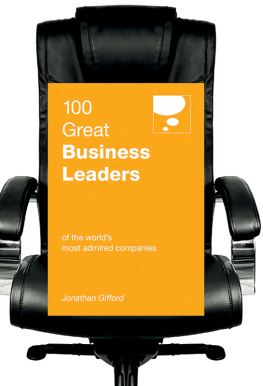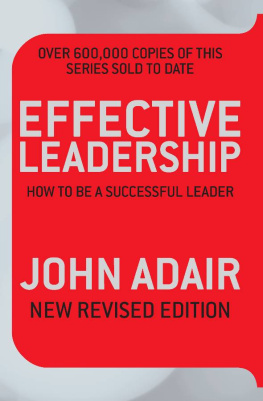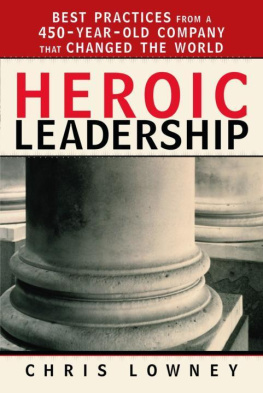
Copyright 2013 Jonathan Gifford
Published in 2013 by Marshall Cavendish Business
An imprint of Marshall Cavendish International
1 New Industrial Road, Singapore 536196
All rights reserved
No part of this publication may be reproduced, stored in a retrieval system or transmitted, in any form or by any means, electronic, mechanical, photocopying, recording or otherwise, without the prior permission of the copyright owner. Request for permission should be addressed to the Publisher, Marshall Cavendish International (Asia) Private Limited, 1 New Industrial Road, Singapore 536196. Tel: (65) 6213 9300. Fax: (65) 6285 4871. E-mail:
The publisher makes no representation or warranties with respect to the contents of this book, and specifically disclaims any implied warranties or merchantability or fitness for any particular purpose, and shall in no events be liable for any loss of profit or any other commercial damage, including but not limited to special, incidental, consequential, or other damages.
Other Marshall Cavendish Offices:
Marshall Cavendish Corporation. 99 White Plains Road, Tarrytown NY 10591-9001, USA Marshall Cavendish International (Thailand) Co Ltd. 253 Asoke, 12th Flr, Sukhumvit 21 Road, Klongtoey Nua, Wattana, Bangkok 10110, Thailand Marshall Cavendish (Malaysia) Sdn Bhd, Times Subang, Lot 46, Subang Hi-Tech Industrial Park, Batu Tiga, 40000 Shah Alam, Selangor Darul Ehsan, Malaysia.
Marshall Cavendish is a trademark of Times Publishing Limited
National Library Board, Singapore Cataloguing-in-Publication Data: Gifford, Jonathan Lewis.
100 more great leadership ideas : from successful leaders and managers around the world / Jonathan Gifford. Singapore : Marshall Cavendish Business, 2013 pages cm
eISBN : 978 981 4484 91 6
1. Leadership. 2. Creative ability in business. I. Title.
HD57.7
658.4092 dc23 OCN 820782433
Printed and bound by CPI Group (UK) Ltd, Croydon, CR0 4YY
CONTENTS
INTRODUCTION
THIS BOOK WAS WRITTEN in the same way as its predecessor, 100 Great Leadership Ideas. I made notes on the leadership ideas expressed in books, articles and interviews by, about and with established business leaders and management thinkers. When leaders said that some aspect of leadership had been especially important in their careers, or when commentators judged that some particular facet of a leaders behaviour had been a significant contributor to that leaders success, I entered that into a growing spreadsheet of ideas gathered under various new headings: Ask for discretionary effort, for example; Be unpredictable; Learn from (other peoples) failure; Think the unthinkable. As ideas, quotations and comments gathered under these new headings, the next 100 great leadership ideas began to select themselves.
In my introduction to 100 Great Leadership Ideas, I noted that a significant number of leaders were focussing on ideas clustered around the same basic concepts of innovation, the collective wisdom of the organisation, and the need for leaders to surround themselves with colleagues from different backgrounds and with differing approaches and ideas. These could all be seen as facets of a fundamental aspect of leadership: the need to find innovative solutions that will drive change and differentiate the organisation from its competitors.
This theme re-emerges with even greater vigour in this new book. Successful leaders stress, time and again, that their job is to set the direction to set out a compelling and exciting vision of where the organisation will be in the near future, and of what it will feel like to be part of that process. The leaders dont themselves know exactly how the organisation is going to get to this new place; if they did, leadership would not be needed a team of managers could map out the process of getting from Point A to the well-known and clearly understood Point B, whereas Point B is, in fact, by definition, a mystery. Great leaders know what Point B will look and feel like when it is reached, but they need the organisation to figure out exactly how this new state of affairs which is best defined as a way of being, rather than as a destination will be achieved.
In order to get to this different way of being, one thing is needed above everything else: new thinking new ideas, new approaches, new mindsets. Several leaders stress that creating an innovative, entrepreneurial mindset in the organisation requires major structural change. We have allowed ourselves to believe that innovation stems only from dedicated R&D departments and from top leadership; in fact, real innovation will come from the entire organisation (and even, importantly, from outside the organisation). The most successful leaders through the ages have seen themselves as facilitators leaders who encourage and enable people to deliver the best that they are capable of and to experiment with potentially radical new ideas.
If the need for constant innovation is a key theme of successful leaders today, other concepts emerge that are equally significant. One subtle, but quite profound, idea is the suggestion that the perfect leader would be, in a sense, invisible. On this analysis, successful leadership is about communicating the vision so thoroughly that the organisation moves inexorably in the right direction without the need for high-profile acts of dramatic leadership, and colleagues instinctively avoid courses of action that do not fit with the organisations core principles. When this begins to happen, leadership can stop wasting its time on operational problems and focus on the next strategic opportunity, on the next change needed to keep the organisation ahead of its competitors.
Several leaders stress the hopefully obvious point that organisations are a part of the communities in which they operate. This creates both responsibilities the moral obligation to give something back to the communities that support the organisation and opportunities. The wider community of customers, suppliers, academic institutions and neighbours is a rich source of new ideas that can spark innovations in the organisations products, services and systems.
Thought-provokingly, a number of leaders explore the advantages of organisational structures that are very different from the traditional top-down, hierarchical, command and control approach of the typical modern corporation. The common thread running through these different leadership structures is the benefit derived from a devolution of power that gives meaningful authority to people as close to the front line (the customer) as possible. This is perhaps potentially the most powerful act of modern leadership: to enable colleagues to make their own decisions, derive more satisfaction from their careers and energise the organisation as a whole by means of their many individual contributions.
This brings us to the important conclusion, commented on by many modern leaders, that what is needed in the modern organisation is not only (or even) more leadership from the top, but more leadership from within the organisation at every level. In the modern organisation, almost everyone should expect to show leadership in certain situations.

THIS BOOK IS DIVIDED into four sections: You and the Team, You and the Organisation, You and the Outside World and, simply, You. The grouping of ideas under these headings is not entirely rigid or even scientific; in general, You and the Team contains leaders thoughts on their direct relations with colleagues (e.g. be generous in little things, control your anger, enable creativity); You and the Organisation is more concerned with the leaders relationship to the organisation as a whole (create a flatter structure, ingrain the values, listen to the organisation); You and the Outside World looks at how leaders position their organisations in relation to their various communities (operate sustainably, drive social innovation, welcome competition); while You contains leaders ideas about personal qualities and behaviours that have proved particularly useful to them (have faith in your own ideas, get out of the office, take calculated risks).
Next page











